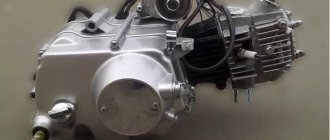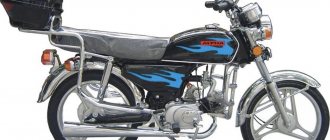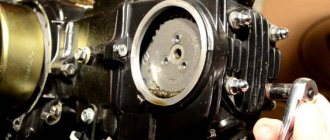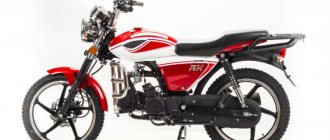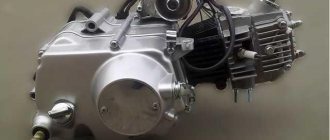Incorrect, the Alpha moped is one of the most popular vehicles in the post-Soviet space. And it’s quite easy to explain. After all, this model harmoniously combines high quality and affordable price. And the characteristics of the moped are excellent.
For every 100 km, the vehicle takes only about 2 liters of fuel. The weight of the model is 80 kg, the load capacity is 120 kg. These indicators are already quite good, at the same time, there are also opportunities to improve the device. We will talk about how to tune this moped in the article .
Tuning features
The topic related to Alpha tuning is quite common, since there are many ways to improve the quality of this moped. At the same time, the cost of modernization will be an order of magnitude lower than in the case of a similar Chinese scooter. After all, Alpha is made quite simply, so access to the power unit and external elements is as convenient as possible.
The model can be improved in various directions, so before starting work you need to decide on the qualities that you want to change. Another important nuance is that you should understand the difference between styling and tuning. The first involves solely changing the appearance, while the second option also affects the functional parameters of the vehicle.
In addition, many see tuning an Alpha moped not just as a task to improve certain characteristics, but also as a real hobby that can keep the owner busy. There are many improvement options, and you can also use your own ideas that optimize the functionality of the device. Now we will focus on each specific area.
It will also be interesting: Suzuki motorcycles: secrets of producing eternal motorcycles
Video review of the Alpha moped:
What can be done?
As we said above, the idea of tuning comes suddenly, and at this moment you most likely already know what exactly you would like to add. If you still don’t know where to start, then think about what you would like to improve? After reading our article, you will find out what interesting things can be done with a moped, and what tuning is the most popular now.
When improving the moped, you can work on the chassis or appearance. And if you can somehow sort out the appearance yourself, then engine tuning is a more serious thing. It is with the engine that we will start.
Improved appearance
Probably every vehicle owner wants his car to look as attractive as possible. That is why tuning mopeds is most often aimed at improving the overall design. At the same time, you can optimize not only the appearance, but also the overall functionality of the model. Some of the most common improvements include:
- replacing the seat with a wider and more comfortable model;
- installation of special panels that protect the legs and also prevent fractures;
- installation of wider wheels (this leads to increased stability, which is especially necessary when replacing the power unit);
- windshield installation. This will help improve your riding comfort. At the same time, such an accessory negatively affects the aerodynamic properties of the model, especially when driving at speeds of 40 km/h or more;
- replacing disks. Here we are talking mainly about aesthetic preferences, since the basic discs are also quite good;
- replacing the plug. Such a solution is necessary if you often drive on rough roads or off-road. By strengthening the shock absorbers, you can significantly reduce the load on the wheels;
- replacement of lighting. New LEDs will be a great option, as they shine brightly and look stylish. But you should not buy xenon lamps, since their quality is not much better, but they will dazzle passing drivers, which can increase the likelihood of unforeseen situations on the road;
- installation of rear view mirrors. The factory model looks quite unpresentable, so new mirrors will greatly change the appearance of the model. Additionally, turn signals can be installed on them, which increases the practicality of the devices.
Finally, it’s time to start painting your iron horse. The choice here is simply huge, so you can give your moped the style you've always dreamed of.
It will also be interesting: Ural motorcycles and the fate of the Irbit plant
Owner reviews
I drive a Zizer 400, the Alpha is parked in a country house in the countryside, there are no roads there, the Chinese is just right. The moped is already five years old, the mileage is less than 10k, the only breakdown is a broken clutch cable. Andrey, Volgograd.
It drives sadly, brakes sadly, looks boring, but what you pay is what you get. For the money, the Alpha RX is a decent bike if you need purely utilitarian transport at minimal cost. Spare parts are a penny, can be repaired on the knee. It copes with its tasks. Alexey, Novorossiysk.
I bought Alfa RX after buying two Chinese scooters - one was broken, the other was stolen. I liked driving with a manual transmission, you feel more confident. It picks up speed up to 60 mph confidently, then it becomes weaker. There is zero light from the standard headlight, so I installed a more powerful bulb. Otherwise ok. Dmitry, Saratov.
Volume expansion
The starting volume of the engine can be increased up to 110 cubic centimeters. At the same time, you need to understand that such a decision will lead to the need to register your vehicle. But it’s worth it, because the engine will begin to behave an order of magnitude more powerful and dynamic. In addition, when tuning a moped, it is also worth replacing the low-quality pistons that come with the kit. This will also have a positive effect on the operation of the engine. Thanks to the new engine, you can significantly increase the speed of your model. In fact, the Alfa will turn into a real motorcycle, and will not be a compact moped.
When replacing a cylinder, you can use components from Delta or Active. On the other hand, then you will have to change not only the cylinder, but also the crankshaft, chains, seals, rollers and, quite likely, even the carburetor.
Improving the filling
To tune a scooter, you also need to replace its CVT with a sports model - such devices are adjusted to the new engine characteristics much better and more accurately. Manufacturers equip modern models of tuning CVTs with a rod lubrication system to increase the efficiency of the entire transmission part of the scooter. Smoother and easier movement of the variator along the hub will significantly improve the scooter's throttle response. You can also increase the performance of a scooter with the help of proper installation of a tuning cylinder-piston group.
Installing the latter is the most radical and effective method of increasing the performance and power of a scooter.
The tuning cylinder-piston group usually comes with a cylinder head, the shape of the combustion chamber of which is optimized. If the owner also plans to install pistons with a larger diameter, it is important to ensure the ideal technical condition of the crankshaft and bearings - otherwise they will very quickly fail due to heavy loads. At this stage, tuning the scooter can be completed, since for other improvements it is easier to buy a more powerful vehicle and not bother with installing expensive tuning parts.
Replacing sprockets
To make the motor work more efficiently, it is also worth replacing the sprockets. This will help further increase the speed of the device. But for the result to be noticeable, it is necessary to mount a 16-tooth sprocket and an enlarged cylinder. This combination is the most optimal.
In addition, you should take a closer look at the condition of the chain. If it is worn or damaged, the sprockets will also wear out faster.
JavaScript is disabled in your browser
Today, modern mopeds are equipped with a huge number of different electronic devices, which naturally operate using electricity. Whatever one may say, even a rechargeable battery needs current, so it requires periodic charging. Optics, battery, starter, tail lights and other electronic devices depend on the generator. The scooter's generator plays a major role in the correct operation of the moped, and the simplicity of its design should be like the ABCs even for novice motorcyclists. After all, this is classical physics - a school curriculum!
The moped generator is a simple flywheel magdino. Electric current is supplied directly to consumers during the rotation of the crankshaft, or more precisely during operation of the power plant. When the flywheel and magnets rotate, electricity is generated. A special charging coil is located inside the flywheel. The magnetic field oscillates in the coil itself, which leads to voltage indication.
A scooter's generator produces only alternating current, but some moped devices require direct current. For example, the battery is charged only with direct current. Let's figure out together how direct current differs from alternating current?
Everyone probably knows that electric current is a directed flow of charged particles along a trajectory from one pole to the next source pole. The process when the flow of charged particles does not change the nature of the movement constantly and does not depend on time is called direct current.
Alternating current refers to a process in which charged particles constantly change the nature and direction of their trajectory. This comparison is elementary and delving into all the nuances of the process does not make sense. In everyday life, examples of alternating current are batteries of mobile phones, tablets, cameras, computers, traditional batteries and other power sources. Just like a moped battery, all of these devices require DC current to charge properly. It is the charging device that converts the mains voltage into the desired one.
The battery requires recharging. The battery must be supplied with direct current. In order to convert alternating current into direct current, a special rectifier is used on the moped. For the current conversion process, diodes are usually used. Naturally, electric current can flow through the diode elements in only one direction, and the reverse process in our situation is filtered, and as a result we have the desired direct current. But that’s not all – all that remains now is to reduce the current indicator to the value we need. A special voltage regulator is responsible for this process in a moped - it is also a rectifier.
The current generated by the generator is passed through the rectifier and the desired voltage appears at the output. Without this conversion of electric current, correct operation of the entire moped as a whole is simply not possible, since the voltage indicator constantly fluctuates depending on the speed of the crankshaft of the power plant.
The moped battery is a constant consumer of electric current, charging which is carried out directly from the generator all the time, even if charging is no longer required. The power indicator of the generator, as a rule, is slightly greater than the power of all other electronic devices on the scooter, therefore, when installing additional optics on the moped, it is necessary to reduce the number of actual consumers and reduce the load on the generator by reducing the voltage consumption of these same consumers.
Running in an improved moped
After the engine has been upgraded, you should start running it in. At the same time, it is better to develop maximum speed in deserted places. Sometimes it happens that the suspension and braking systems cannot cope with the increased power of the power unit, so you will have to use a parachute to brake. If the silent blocks begin to fall out while driving, then the shock absorbers, fork and brake system should be replaced.
You may also be interested in: The main types of motorcycles: choosing an “iron horse”
Not enough speed
If the maximum speed is not enough, we change the gear ratio. You need to put a sprocket with fewer teeth on the rear axle. If there is not enough chain adjustment flow, it will have to be shortened by several links. Overclocking characteristics will change. The first gear will become shorter, but by switching to higher gears and spinning the engine to the maximum, the increase in speed will be noticeable. The maximum speed will increase by ten to fifteen kilometers per hour. By the way, you shouldn’t turn the first gear until it “squeals”. Overheating can cause the bushing in the clutch to become stuck and the neutral will disappear, if not forever, then certainly until the entire clutch crown is replaced.
A short summary
So, if you have an Alpha moped, tuning this vehicle looks like a good option to improve the functionality and power of the model . This kind of work is often very interesting, so it will bring you a lot of positive emotions. Moreover, the design features of the moped provide convenient access to the main components, as a result of which improvements can be made in almost any direction, even without special knowledge in the field of auto mechanics.
Video advice on modifying the Alpha moped:
Lacks low end and traction power
You will have to disassemble the motor and change the technical specifications. Alfa moped engine tuning is provided with components of different prices and quality. A motor of this configuration is an exact copy of a Honda motor that has been produced for many years. There are clubs for moped lovers with this engine all over the world. Road races, enduro and off-road races are held. And, as a rule, where there is serious sport, there is civilian tuning. Forged piston and connecting rod, four-valve head with Ducati-style desmodromic mechanism, dry clutch, water cooling. The injection system is from Yoshimura... But since we are now talking about an Alpha moped, the price of which in the store is less than the cost of any of the listed components, our tuning option is more modest.
Alpha engine tuning
Engine tuning can be immediate aggregate or unit and stage-by-stage. On sale you can find engines with the same method of mounting to the frame, but with a volume of 110 cc, 125 cc or 150 cc. An increase in engine capacity will entail the need to register with the traffic police, but this is an organizational issue. The technical side will be as follows: the electrical wiring remains the same, a larger engine will require a different carburetor and a different exhaust pipe. Most likely, they will be found in the same place as the motor itself.
Ignition circuit elements.
Electronic tachometer on the dashboard.
When the turn signals are on, it makes characteristic clicks with a frequency of about 1 Hz. Also, you cannot replace lamps with more powerful ones. Due to the electronic circuit of the regulator, the voltage on this wire is converted into a pulsating one, and is supplied to powerful current consumers - low and high beam lamps, as well as dashboard backlight lamps, there may be several of them.
This is what the relay regulator looks like on a scooter. Due to its primitive circuitry, the relay-regulator often fails. Basic Concepts In order to understand wiring, you need to understand a little about the types of current. The starting relay receives a thick red wire from the positive terminal of the battery. The alternating voltage is removed from the white wire and supplied to the relay regulator for subsequent straightening and stabilization.
Inspired by Philips MP1002C
In the mid-80s, I had the pleasure of witnessing testing of a Philips MP1002C generator set that actually worked. The experience made a deep impression on me, especially in how calmly the Stirling started up and came to life. The maximum noise came from the burner (combustion chamber), but ultimately the Philips engine produced a very pleasant sound background - all that needed to be replaced were the noisy bearings.
As the old saying goes, “It worked and worked like a Singer sewing machine!” At the time, my experience with Stirling engines consisted of designing a few bench-top sized models, but after seeing and hearing a Philips engine in action, I wanted to design, design and build an engine of the same caliber...make something large enough that it would produce a useful, perceptible work.
Engine configuration. Trial and error
After much thought (and several years of frustration), I realized that there were mistakes in this configuration. First of all, in any Stirling engine the heater, regenerator, and refrigerator must be “monoblock”, that is, they are placed in close proximity to each other. This means that these three thermodynamic components should all be located away from the engine's displacer, instead of being "scattered" throughout the gas path as I did on the MK I. This clever design is very important for good performance and such a tight monoblock the layout is clearly visible on all Philips engines. The fact that I placed the regenerator in close contact with the engine block allowed heat to escape along the entire length of the engine - this is clearly a bad decision in the Stirling design.
Source


